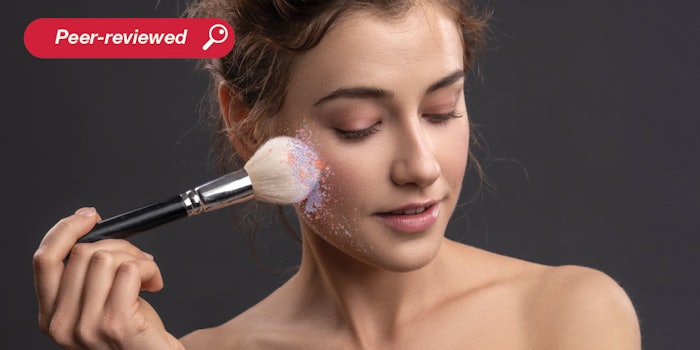
Read the full article in the March 2022 digital edition. . .
A splash of color can brighten anyone’s mood, and color cosmetics have the power to change the way a person feels about themselves in seconds. The color cosmetics sector is exhibiting strong growth due in part to increasing enthusiasm for makeup stimulated by social media.1, 2 Consumer media reports that keeping skin looking fresh despite stress will continue to be one of the biggest makeup trends in 2022. According to Cosmopolitan, “a minimal base with a natural finish that is clean and hydrated proves that less is more.”3
As formulators know, coloring agents impart color to a product that will subsequently be used on the lips, eyes, skin or other approved parts of the body. Coloring agents are classified as dyes or pigments according to their structure, source, color, solubility and application method. Typically, pigments are solid inorganic particulate forms such as titanium dioxide (TiO2), zinc oxide (ZnO) and iron oxide (Fe2O3).
These particles are insoluble in formulations, making their incorporation into cosmetic products a technically challenging process. They cannot simply be stirred into solvents and emulsions; thus their uniform dispersion and distribution is a critical point for achieving a high-quality, functional and aesthetically pleasing finished product.4-7
The insufficient dispersion of pigment powders can lead to problems with color development and instability of the final formulation. In the absence of stabilizing agents, effects such as reduced color strength, decreased gloss and altered rheology may then occur, and these parameters will eventually impact product success.8-10 Subsequently, pigments whose particle sizes are optimized and that demonstrate long-term stability in dispersions are key.
To overcome these challenges, different technologies have been developed and commercialized. Typically, they are surface modifications, coatings and other treatments made to the pigment particles. These solutions improve the pigments’ poor hydration, dispersibility, skin feel, chemical stability and other properties by altering the physicochemical properties of the pigments. This achieves the desired functions and aesthetic appeal.9-12 Nevertheless, these solutions and technologies are limited due to safety concerns and for their potential environmental impact—most are based on silicones, organic solvents, reactive coating materials, silanes, free radicals and surfactants.9-13
Selecting the proper coated/treated pigment for use in a formulation is also challenging, and if chosen incorrectly can lead to:
- Color shift and weak color strength due to the dissolution and removal of coating materials by the various oils and solvents composing the formulation;
- Formulation instability due to incompatibilities14 between ingredients composing the base formulation and the coating/treatment materials; and
- Poor color uniformity and adhesion to the skin.14
To overcome these challenges in formulating with inorganic pigments, i.e., iron oxides, and to provide a market-differentiating color-change effect in finished products, a micro-encapsulation technology was developeda whereby the color or pigment is released only upon the application of mechanical pressure, such as through rubbing. The pigment is fully shielded from the surrounding formula using a bio-based biodegradable15 polymer and the color is revealed only when the customer uses the finished product.
The present article describes the preparation of the encapsulated iron oxide pigments and their physicochemical characterization. In addition, the color release effect is demonstrated in an o/w cream, and the stability and safety of the pigments are evaluated.
. . .Read more in the March 2022 digital edition. . .
References
- Fardouly, J. and Vartanian, L.R. (2016). Social media and body image concerns: Current research and future directions. Curr Opin Psychol 9 1-5.
- Gürses, A., Açikyildiz, M., Güne¸s, K. and Sadi Gürses, M. (2016). Classification of dye and pigments. Dyes and Pigments (SpringerBriefs in Molecular Science). Springer: Cham, Switzerland 31-45.
- Reid, K. and Jowett, V. (2021, Jun 30). 10 makeup trends to jump on before the rest of your IG feed. Available at https://www.cosmopolitan.com/uk/beauty-hair/beauty-trends/g14009805/big-makeup-trends/
- Chisvert, A. and Salvador, A. (2007). Coloring agents in decorative and other cosmetics. Analytical methods. In Analysis of Cosmetic Products, 1st edn. Elsevier, Amsterdam ch 4.
- Lu, S., Pugh, R.J. and Forssberg, E., eds. (2005). Chapter 3 modification of particle surfaces. Available at https://www.sciencedirect.com/science/article/abs/pii/S1383730305800043?via%3Dihub
- Maile, F.J., Pfaff, G. and Reynders, P. (2005). Effect pigments—Past, present and future. Progress in Organic Coatings 54(3) 150-163.
- Pfaff, G., Gabel, P., Kieser, M., Maile, F.G. and Weitzel, J. (2008). Special effect pigments: Technical basics and applications. Available at https://bit.ly/3risWqM
- Tsolis, P. and Castro, J. (2013, May 8). Troubleshooting atability, uniformity in formulations. Available at https://bit.ly/3gV1Znc
- Bartholomey, E. (2015 Jun). An overview of surface treatments for pigments and powders. Available at http://www.koboproductsinc.com/Downloads/Kobo-Surface-Treated-Pigments-and-Powders-Combined-June2015.pdf
- Lankem (2019, Sep 13). Surface treatment of pigments. Available at https://www.lankem.com/post/surface-treatment-of-pigments
- Schauer, T. and Elsenbach, C.D. (2003). Organic polymer treatment-The way to modern pigments. European Coating J 114-120.
- Jadhav, S.A., Bongiovanni, R., Marchisio, D., Fontana, D. and Egger, C. (2014). Surface modification of iron oxide (Fe2O3) pigment particles with amino-functional polysiloxane for improved dispersion stability and hydrophobicity. Pigment & Resin Technology 43(4) 219-227.
- Cosmeticobs (accessed 2022, Feb 17). Pigments treated or coating or coating techniques. Available at https://bit.ly/3I1RsT1
- O’lenick, T. (2020). Evaluating coated pigmented products. HPC Today 15(2).
- Puls, J., Wilson, S.A. and Holter, D. (2011). Degradation of cellulose acetate-based materials: A review. J Polym Environ 19 152-165.
a Cameleon CelluBrown (INCI: CI 77499 (and) Iron Oxide CI 77492 (and) Iron Oxide 77491 (and) Titanium Dioxide CI 77891 (and) Cellulose Acetate (and) Propylene











